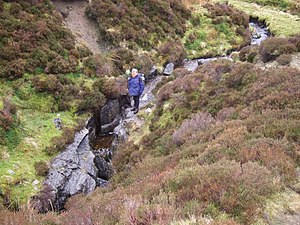Lost John's Cave
| Lost Johns' Cave | |
| Lancashire | |
|---|---|
 Stream leading into the main entrance | |
| SD670786 | |
| Co-ordinates: | 54°12’9"N, 2°30’22"W |
| Depth: | 692 feet |
| Length: | 3 miles |
| Access: | CNCC Permit |
| Geology: | Carboniferous limestone |
Lost Johns' Cave is the most extensive cave system on Leck Fell in the north of Lancashire. It is found in the very north of the main body of Lancashire (South of the Sands), in the projection of the county amongst he fells between Westmorland and the West Riding of Yorkshire.
The cave is an important part of the Three Counties System, a cave system which spreads beneath the fells across Westmorland, Lancashire and Yorkshire.
Caving
With its three major vertical routes (Dome Route, Centipede Route and Monastery Route) it is a popular place to practise single rope technique because of the opportunity for exchange trips.[1] Further, the cave can be safely visited on wet days because many of the pitches can be rigged out of the water.
All routes in Lost John’s Cave converge on Battleaxe Streamway. From here the usual route is to shuffle along Battleaxe Traverse at a high level protected by rope, and descend a safe distance from the water. From here a short passage and another pitch leads to Groundsheet Junction where the Leck Fell Master Cave is entered.
Upstream leads to the Lost Pot Avens, Lyle Cavern and two other entrances from Boxhead Pot and It's a Cracker, as well as a connection with the Notts Pot system.
Downstream leads through several neck-deep pools past several inlets, including one which links with Rumbling Hole, and another which links to Deaths' Head Hole, to a sump which, after 2,620 feet, connects with Pippikin Pot.
See also
References
- ↑ Marshall, D. and Rust, D. (1997). Selected Caves of Britain and Ireland. Cordee. ISBN 1-871890-43-8.